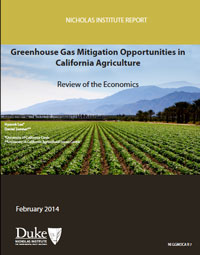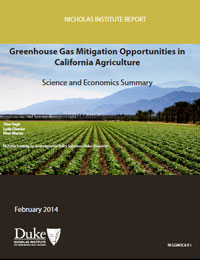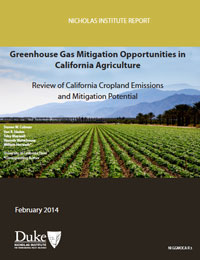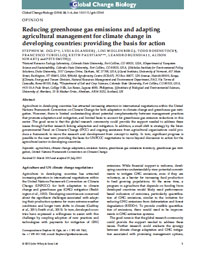Publications
Biogas in the United States: An Assessment of Market Potential in a Carbon-Constrained Future
Using biogas as a fossil fuel substitute can mitigate the buildup of greenhouse gases in the atmosphere. Therefore, biogas is an attractive renewable energy source in a carbon-constrained future. Although pipeline-quality biogas can augment the natural gas market supply, its long-term potential has been little studied. This report aims to answer the question of whether, and under what conditions, a substantial, decentralized domestic biogas market could develop in the United States by 2040. It finds that (1) biogas could be expanded to supply perhaps 3–5% of the total natural gas market at projected prices of $5–6/MMBtu, (2) the largest potential biogas is thermal gasification of agriculture and forest residues and biomass, (3) using biogas for electricity generation may be more profitable than supplying it to the pipeline, and (4) because market signals have not spurred widespread adoption of biogas, policy incentives are necessary to increase its use.
Greenhouse Gas Mitigation Opportunities for California Agriculture: Review of Emissions and Mitigation Potential of Animal Manure Management and Land Application of Manure
Manure management, primarily in anaerobic lagoons on dairies, is estimated to be the largest source of greenhouse gases from California agriculture. However, no field measurements from dairies in California have been published. A review of the broader literature revealed that emissions from anaerobic lagoons had more than 10 times the global warming potential of emissions from solid manure piles. Capping anaerobic lagoons and flaring the emitted methane, or fully converting to anaerobic digesters, could reduce total methane emissions by 92% (~7.7 Tg CO2e). Manure from farms is eventually applied to agricultural fields as fertilizer, where nitrous oxide is the primary greenhouse gas (GHG) emitted. Limited data are available on GHG emissions from manure-amended fields, and only two studies were conducted in California. This research suggested that fertilizing agricultural fields with manure rather than synthetic fertilizers results in lower GHG emissions as well as increased soil carbon storage. Despite the significance of dairy manure in GHG budgets at the state, regional, and global scale, this review reveals a surprising lack of field-scale research necessary to inform the development of best practices in California. Key areas of research for California include measurements of GHG emissions from dairy manure management systems and comparisons of GHG emissions from agricultural fields under different management practices.
Greenhouse Gas Mitigation Opportunities in California Agriculture: Science and Economics Summary
California Assembly Bill 32 requires effective statewide greenhouse gas (GHG) reduction strategies. This report summarizes the results of six studies--developed to inform California policy--that review the latest science and economics of GHG mitigation opportunities in California's agricultural sector. Specifically, the report examines the potential for annual GHG reductions in cropland, rangeland, and manure management systems and through emissions-targeted optimization of feed for dairy animals. Among the examined practices, dairy manure management appears to provide the largest emissions reduction opportunity at the lowest cost per ton, but economic and other hurdles must be overcome to realize it. Other mitigation activities could yield relatively large per-acre reductions but on relatively small acreage. Yet other activities could be widely implemented, but their potential effectiveness is uncertain. More data on the GHG reduction potential and costs of management practices in California agriculture and a better understanding of adoption barriers are needed.
Greenhouse Gas Mitigation Opportunities for California Agriculture: Review of the Economics
Although about three-quarters of California farm revenue derives from crop production, crops—mainly tree, vine, and vegetable crops—account for only about one-quarter of GHG emissions. Some studies indicate minimal yield loss from reducing nitrogen fertilizer use, and simulation results show significant percentage reductions in GHG emissions for payments of $20/MTCO2e. The economics of reducing emissions from enteric fermentation has been little studied. Manure management to reduce GHG emissions (mainly methane) can be as simple as covering manure lagoons and flaring methane. The more complex option of using manure-generated methane gas to replace fossil fuels has been investigated often. Most case studies and simulations suggest this option is costly. Its economic feasibility depends on specific local conditions, but there is no evidence of large-scale feasibility in California without large subsidies.
Greenhouse Gas Mitigation Opportunities for California Agriculture: Outlook for California Agriculture to 2030
California agriculture is diverse and complex, producing several dozen major crop and livestock commodities using the state’s great spatial variation of natural and climate resources and well-developed infrastructure of input delivery systems, processing systems, and marketing services. What, where, and how these commodities are produced reflect biophysical, economic, and policy drivers, all of which have and will continue to change. This report examines the statewide greenhouse gas (GHG) emissions and emissions mitigation potential of alternative futures for California agriculture through 2030. It finds that the dairy industry in California has by far the largest GHG emissions of all the state’s agricultural production systems but that the industry’s growth trajectory is uncertain. Three potential growth scenarios suggest that baseline dairy emissions could decrease by as much as 20% or increase by as much as 40% (almost one-quarter of the entire agricultural sector’s current emissions). This variation in baseline emissions projections may be as large as or larger than the industry’s emissions mitigation potential.
Greenhouse Gas Mitigation Opportunities for California Agriculture: Review of California Cropland Emissions and Mitigation Potential
Agriculture contributes approximately 7% of California’s total greenhouse gas (GHG) emissions; less than 3% of the state total comes from croplands. Efforts to reduce California’s agricultural GHG emissions from croplands will require sound information regarding how specific agricultural management practices impact those emissions over the landscape. A review of agricultural literature was conducted on studies that quantified GHG emissions in California annual and perennial croplands. This report reviews the available scientific literature relevant to GHG emissions from California croplands and quantitatively assesses the biophysical potential of various agricultural mitigation strategies relevant to California cropping systems. A total of 20 studies were identified, relating to 10 specific management practices in California croplands. Where possible, data from these studies were used to estimate the biophysical mitigation potential of various agricultural management practices. This work revealed that 3 of the 10 management practices—farmland preservation, expansion of perennial crops, and manipulation of nitrogen fertilizer rates—have high to medium relative mitigation potential. However, reliably estimating the biophysical mitigation potential of these practices is not possible at this time due to many uncertainties and lack of information. Relatively few field studies conducted in California rigorously examine GHG emissions from changes in agricultural management activities and practices. Thus, more research is needed to inform future management and policy alternatives.
Greenhouse Gas Mitigation Opportunities for California Agriculture: Review of California Rangeland Emissions and Mitigation Potential
Rangelands cover approximately 50% of California and have considerable potential to mitigate climate change. Several management strategies offer opportunities to build soil carbon and reduce greenhouse gas emissions. Grazing management can increase soil carbon, but significant uncertainties remain and best management practices are unknown. Long-term, well-replicated studies are urgently needed to explore the potential of grazing management for climate change mitigation. Organic amendments, particularly compost, can enhance biomass and sequester carbon on grasslands while reducing emissions from the waste sector. This strategy shows significant potential but requires additional research, particularly in arid rangelands. High-efficiency synthetic fertilizer use, plant community management, fire management, and irrigation can also influence soil carbon; however, these strategies could be challenging to scale up over large areas, and their net greenhouse gas impacts are uncertain. Remote sensing, biogeochemical modeling, and life-cycle assessments should be leveraged to identify and implement mitigation strategies.
Greenhouse Gas Mitigation Opportunities for California Agriculture: Minimizing Diet Costs and Enteric Methane Emissions from Dairy Cows
The study aimed to determine baseline methane emissions from California dairies and assess mitigation strategies. Two optimization models based on linear programming were developed to formulate minimum cost and minimum methane diets without compromising production. A third model uses weighted goal programming for joint minimization of dietary costs and emissions. The economic and environmental impact of using a specific agent (monensin) was also assessed. Enteric emissions ranged from 18.8 to 25.1 MJ/d. Dairies that used corn/alfalfa-based forages and cows with higher intakes and production were low emitters. The cost per unit emissions reduction ranged from $5.02 to $20.1/kg methane ($239– $956/tonne CO2 equivalent) for a 1% to 25% reduction of total emissions. Various levels of trade-offs between cost and emissions reduction are possible. Up to a 9.4% reduction in CH4 emissions was possible with monensin (costs ranged from $3 to $26/kg CH4). Mitigation options need to be tested in a commercial setting before recommendation for use.
Reducing Greenhouse Gas Emissions and Adapting Agricultural Management for Climate Change in Developing Countries: Providing the Basis for Action
Agriculture in developing countries has attracted increasing attention in international negotiations within the United Nations Framework Convention on Climate Change (UNFCCC) for both adaptation to climate change and greenhouse gas mitigation. However, there is limited understanding about potential complementarity between management practices that promote adaptation and mitigation, and limited basis to account for greenhouse gas emission reductions in this sector. The good news, the authors write in the journal Global Change Biology, is that the global research community could provide the support needed to address these issues through further research linking adaptation and mitigation. In addition, a small shift in strategy by the Intergovernmental Panel on Climate Change and ongoing assistance from agricultural organizations could produce a framework to move the research and development from concept to reality. In turn, significant progress is possible in the near term providing the basis for UNFCCC negotiations to move beyond discussion to action for the agricultural sector in developing countries.
Economics of Forest Carbon Sequestration as a Climate Change Mitigation Strategy
Forest ecosystems remove carbon dioxide from the atmosphere and convert it to organic carbon stored in terrestrial pools of biomass, soil, and residues. This process lowers atmospheric carbon dioxide concentrations, thereby mitigating a contributor to future climate-change threats. This article in the journal Encyclopedia of Energy, Natural Resource and Environmental Economics explores the economics of incentive-based approaches to managing forests and changing land use to store more carbon, such as those that are part of ongoing policy efforts throughout the world. It shows how incentives for carbon sequestration change the optimal time to harvest a timber stand, thereby working the intensive supply margin, increasing the amount of carbon stored in forests over time. It also shows how carbon compensation can attract land into forests from less carbon-sequestering land uses such as crop agriculture, thereby increasing carbon storage on the extensive margin. It provides examples from empirical studies of carbon sequestration from afforestation, forest management, and reduced emissions from deforestation.










